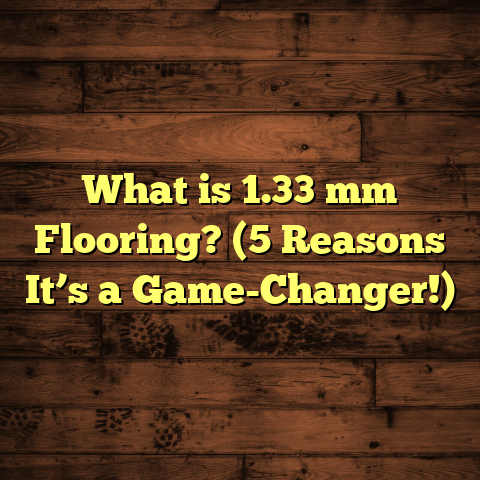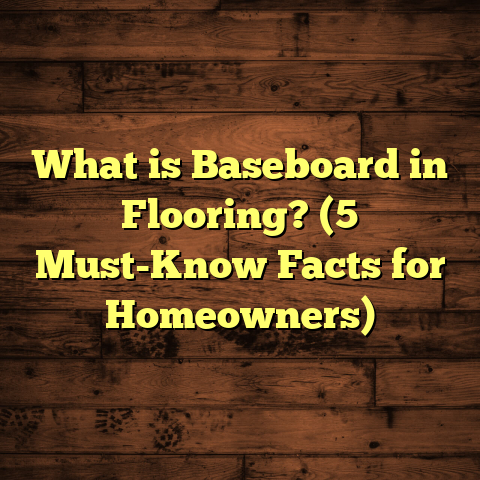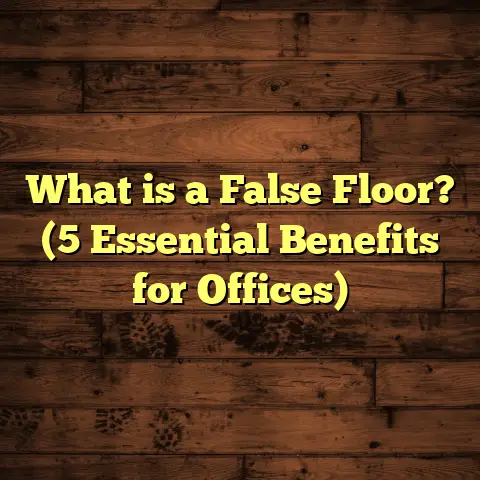What is Under Old Hardwood Floors? (5 Surprising Findings Inside)
What Is Under Old Hardwood Floors?
When I first started working as a flooring contractor, I thought I knew what to expect beneath old hardwood floors. After all, hardwood floors have been a beloved choice for centuries, known for their durability and timeless appeal. But over the years, I discovered that what lies underneath those beautiful planks is often far more complex—and fascinating—than I imagined. It’s like peeling back layers of history with every project. Sometimes, I find things that surprise me, even after decades in the field.
If you’re curious about what’s beneath your old hardwood flooring, you’re in for a revealing journey. Let’s talk about what’s really hidden under those floors, why it matters, and what you might expect if you ever decide to take a closer look yourself.
The First Time I Lifted an Old Hardwood Floor
The very first time I removed an old hardwood floor during a renovation project, I was stunned. The house was built in the early 1900s, and the floorboards had that classic warm oak look, worn and scratched from decades of life. As I pulled up a board, I didn’t just find a simple subfloor. Instead, I uncovered thick wooden planks laid down nearly a century ago—original to the house.
Beneath those planks was another layer of thin boards, and nestled under all that was a rough dirt floor. It was like peeling back time itself. This moment shaped how I approached every future project because it taught me that floors tell stories—stories about the home’s age, its past owners, and sometimes its hidden problems.
What Is Under Old Hardwood Floors?
Under old hardwood floors, you typically find several layers that serve different functions. These include:
- Finish hardwood flooring: The visible top layer made from solid wood boards or engineered wood.
- Subfloor: Usually made of plywood or wooden planks; it provides structural support.
- Joists: The wooden beams under the subfloor that support the entire floor structure.
- Insulation or vapor barriers: In some cases, especially in older homes, there may be materials like paper, fabric, or modern foam to prevent moisture or sound transmission.
- Foundation or ground: Depending on the home’s construction type, this could be concrete slab, crawl space dirt floor, or stone.
Each layer has its own role in providing stability, comfort, and protection for your hardwood floor. However, the types of materials and their condition can differ widely depending on the house’s age, location, and previous renovations.
1. Original Wooden Plank Subflooring – A Window into History
One of the things I’ve found most often beneath old hardwood floors is original plank subflooring. These aren’t your typical plywood sheets but thick wooden boards—often pine or fir—ranging from 1 to 2 inches thick.
Why Is This Important?
Old plank subfloors were built to last. Builders in the late 19th and early 20th centuries used heavy lumber as subfloors because it was readily available and strong enough to hold up under heavy traffic and furniture. Unlike modern plywood, these planks were often laid perpendicular to joists with nails driven deep into the wood.
From a restoration perspective:
- These planks add stability.
- They can sometimes be sanded and refinished if exposed.
- They often come with unique nail patterns called “cut nails,” which are less likely to loosen compared to modern nails.
I remember a project in a 1915 Victorian home where we exposed these original planks instead of covering them up. The homeowners loved seeing the authentic wood grain with its natural patina—it gave the space character no new flooring could match.
Risks with Original Plank Subfloors
That said, these planks aren’t perfect. Over decades, moisture can cause rot or warping. Termites and other wood-boring insects love these older woods too. In one job in the South, termite damage beneath plank subfloors required complete replacement of several joists before we could proceed.
2. Multiple Layers of Flooring – More Than Meets the Eye
Have you ever wondered what happens to old floors when homeowners renovate? Often, instead of removing existing hardwood floors, new flooring layers get installed right over the old surface.
In my experience, it’s not unusual to uncover multiple layers beneath a hardwood floor:
- Original hardwood beneath newer hardwood
- Vinyl or linoleum from mid-century updates
- Carpet padding or particleboard layers from recent remodels
This layering can cause headaches for anyone trying to restore a smooth, flat surface. Each additional layer adds height and can create uneven spots or squeaks when boards rub against one another.
In a house I worked on last year built in 1938, we found three layers stacked:
- Original oak hardwood from 1938
- A linoleum sheet put down in the 1960s
- A modern engineered wood floor installed over everything in 2010
Removing all layers was necessary to address moisture trapped between them and to prevent mold growth. It’s easy to underestimate how much hidden material buildup can affect your project timeline and budget.
3. Subfloor Materials Vary Widely by Era and Region
Subfloors are the foundation of any hardwood floor system—they must be strong enough to support weight and stable enough to prevent warping. But not all subfloors are created equal.
Here’s what I’ve learned about subfloor materials over decades of work:
Wooden Plank Subfloors (Pre-1950)
As mentioned earlier, thick wooden planks were common before plywood became popular. These plank subfloors offer great strength but can be prone to moisture damage if not maintained.
Plywood Sheets (Mid-Century Onward)
Plywood started replacing plank subfloors around the 1950s because it was cheaper and easier to install. Plywood offers better dimensional stability but isn’t as thick or strong as plank.
Oriented Strand Board (OSB) (Late 20th Century)
OSB became popular after plywood due to its cost-effectiveness but is less resistant to moisture damage.
Concrete Slabs
In some houses built on slabs (common in warmer climates), the hardwood floor sits directly over concrete with a moisture barrier and underlayment in between.
In one home built in 1947 in Florida, we found concrete slab under the hardwood floor instead of wood. This required specific vapor barriers and adhesives for successful installation of new flooring.
Dirt or Stone Foundations (Very Old Homes)
In some rural properties from the early 1900s or earlier, floors were laid directly over stone foundations or even packed earth in basements or crawl spaces.
4. Hidden Problems Underneath That Can Ruin Your Floor
Here’s where things get serious: what you don’t see under old hardwood floors can wreck your renovation if left unchecked.
Moisture Damage
Moisture is probably the biggest enemy of any wood floor system. Leaks from plumbing, poor ventilation in crawl spaces, or high humidity can cause:
- Rotting subfloor
- Warped or cupped boards
- Mold growth
On one project in an old farmhouse, hidden water damage caused by decades-old pipe leaks had weakened the subfloor so much we had to replace nearly half of it before installing new hardwood.
Insect Infestation
Termites and carpenter ants love wood subfloors and joists. Signs include small holes, hollow-sounding wood, or sawdust piles.
I once removed a section of flooring only to find termites had eaten through joists below—luckily caught early before structural damage worsened.
Uneven Surfaces & Squeaks
Warped boards or loose nails lead to uneven floors that creak when walked on. Sometimes this is due to settling foundations or poor subfloor installation decades ago.
Fixing squeaks often means tightening nails or adding screws into joists after lifting flooring boards.
Nails & Construction Debris
Years of renovations often leave behind nails, staples, or leftover debris trapped between layers—all potential hazards for new flooring installations.
5. Unexpected Insulation & Soundproofing Layers
It might surprise you that some older homes have insulation layers right under their floors—though not always modern ones!
Here’s what I’ve encountered:
- Newspapers and fabric: Homeowners used newspapers or cloth strips between floorboards as cheap insulation or vapor barriers.
- Asbestos-containing materials: Unfortunately common in mid-century homes as backing for vinyl tiles or adhesives.
- Foam pads: More recent renovations sometimes add foam padding under engineered hardwood floors for sound dampening.
When working on a mid-century ranch-style home last year, we found multiple layers of old newspapers under the hardwood floorboards acting as insulation—a quirky but effective solution back then.
Why Does This Matter? How Knowing What’s Underneath Helps You
You might wonder why all this matters beyond satisfying curiosity. Here’s why:
Budgeting & Planning
Knowing what lies beneath helps estimate costs accurately. Finding multiple flooring layers means more labor; discovering damage means repairs; hazardous materials mean specialized removal—all factors affecting your budget.
According to a report by HomeAdvisor, hidden subfloor issues can add anywhere from 10% to 40% more to flooring project costs if discovered late.
Material & Installation Choices
Different subfloors require different adhesives and installation methods. For example:
- Plywood needs nails/screws and glue.
- Concrete slabs need moisture barriers.
- Dirt crawls require vapor barriers and sometimes plywood overlay.
Choosing wrong products leads to premature floor failure.
Longevity & Comfort
Addressing problems like moisture or unevenness upfront ensures your new or restored hardwood floor lasts longer and feels solid underfoot without squeaks.
How I Inspect Floors Before Work Begins
I’ve developed a routine over years that helps me uncover what’s going on underneath without causing unnecessary damage:
- Visual Check: Look for surface signs like warping or discoloration.
- Moisture Testing: Use meters at different spots.
- Removing Boards Carefully: Lift a few boards at non-visible areas.
- Assessing Subfloor Condition: Look for rot, insect damage.
- Documenting Layers: Take notes/photos for planning.
This method saves time and surprises during actual work.
Detailed Case Study: Restoring a 1905 Craftsman Home Floor
To give you an idea of how these findings play out in real life:
Background:
The homeowners wanted their century-old hardwood floors restored after years of carpet covering them. They expected simple sanding but were unprepared for what lay beneath.
Findings After Removing Carpet:
- Original wide pine planks from 1905
- A layer of plywood added mid-century
- Evidence of minor water damage near windows
- Rusted tack strips from carpet installation
Challenges & Solutions:
- Replacing damaged plywood sections while preserving original planks
- Using wood hardener on slightly rotted areas
- Sanding back pine planks carefully to avoid damaging thin edges
- Sealing with modern finishes that matched historic look
The result was a stunning floor that preserved authenticity while ensuring durability for another century.
Flooring Layers Across Different Eras: Data Insights
Here’s a breakdown based on my experience combined with industry data showing what typical floors look like by construction era:
| Era | Subfloor Material | Flooring Layers Typical Count | Common Issues |
|---|---|---|---|
| Pre-1920 | Thick pine/fir planks | 1–2 | Rot/insect damage |
| 1920–1950 | Wood planks + plywood | 2–3 | Moisture buildup between layers |
| 1950–1980 | Plywood | 2–3 | Vinyl/linoleum overlays |
| Post-1980 | Plywood/OSB | 1–2 | Generally stable; moisture risk |
This helps me set expectations quickly when inspecting homes by age.
Personal Tips If You’re Removing Old Hardwood Floors Yourself
If you want to lift your old floors yourself—here are some tips based on my experience:
- Use pry bars gently near walls to avoid damaging boards.
- Remove a few boards first to inspect underneath.
- Check moisture levels before proceeding.
- Watch out for nails sticking out!
- Take photos as you go for reference.
- If you find mold or suspect asbestos, stop work and call professionals immediately.
- Don’t assume all old wood is damaged—some may be great candidates for restoration.
Final Thoughts on What Lies Beneath Your Hardwood Floors
Old hardwood floors are more than just surface beauty—they hide layers full of history and surprises. From thick plank subfloors to multi-layered flooring systems, each layer tells a story about how your home evolved.
Understanding what lies beneath helps you avoid costly mistakes and make informed decisions about restoration or replacement. And sometimes? It reveals hidden treasures worth preserving—like original wooden planks with character no new flooring can match.
If you ever decide to pull up your old floors yourself or hire someone to do it—take a moment to appreciate what those hidden layers say about your home’s story.
Do you have any experiences lifting old floors? Found anything surprising? I’d love to hear your stories!





